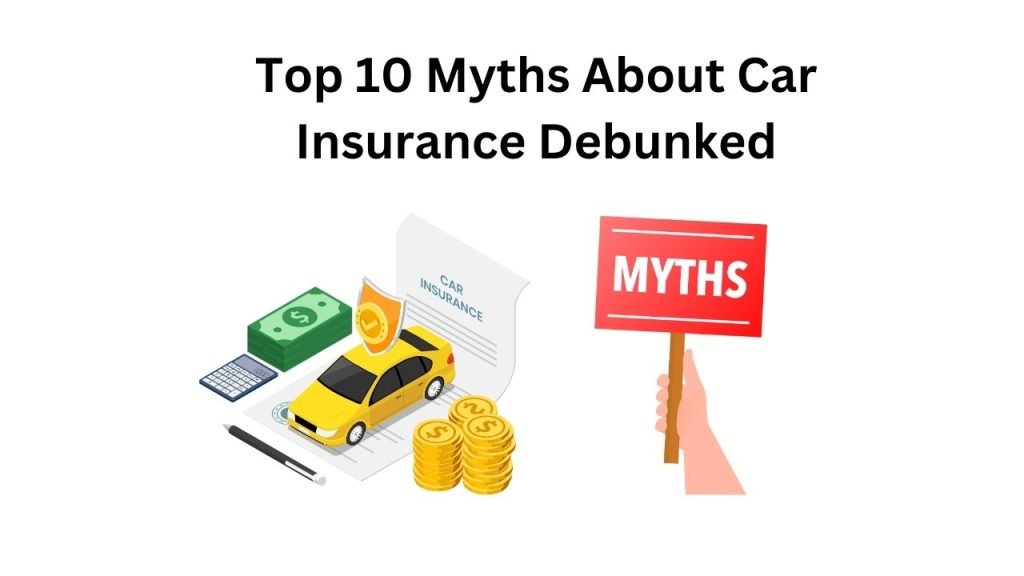Introduction
Car insurance is a necessary aspect of vehicle ownership that offers financial protection in case of accidents, theft, or other unforeseen events. Despite its importance, many drivers harbor misconceptions about how car insurance works, which can lead to costly mistakes. In this article, we’ll debunk the top 10 myths about car insurance to help you make informed decisions and avoid common pitfalls.

Myth 1: Red Cars Cost More to Insure
There’s a long-standing belief that owning a red car will result in higher insurance premiums. The truth is, the color of your car has no impact on your insurance costs. Insurance companies are more concerned with factors such as the car’s make, model, age, engine size, and the driver’s history. So, if you have your heart set on a flashy red car, go ahead and buy it without worrying about higher insurance rates.
Myth 2: Older Drivers Pay More for Car Insurance
While it’s true that young drivers typically pay higher premiums due to their lack of experience, the myth that older drivers always pay more isn’t accurate. In fact, many insurance companies offer discounts to older drivers who have clean driving records. Factors like driving experience, accident history, and the type of car being insured play a significant role in determining insurance rates, regardless of the driver’s age.
Myth 3: Your Credit Score Doesn’t Affect Your Car Insurance Rates
Many drivers are unaware that their credit score can influence their car insurance rates. Insurers use credit-based insurance scores to predict the likelihood of a policyholder filing a claim. A lower credit score might indicate higher risk, leading to increased premiums. Maintaining a good credit score can, therefore, help you secure lower car insurance rates.
Myth 4: Comprehensive Coverage Protects You in All Situations
Comprehensive coverage is often misunderstood as a catch-all policy that covers any type of damage to your car. In reality, comprehensive coverage protects against specific non-collision-related incidents such as theft, vandalism, natural disasters, and animal damage. It does not cover collision damage or mechanical breakdowns, so it’s essential to understand the limitations of comprehensive coverage and consider additional policies if necessary.
Myth 5: Minimum Coverage is Enough
Many drivers opt for the minimum required coverage to save on premiums, but this can be a risky move. Minimum coverage might not provide adequate financial protection in the event of a severe accident. It often only covers the bare essentials, leaving you responsible for any additional costs. It’s wise to assess your needs and consider purchasing higher liability limits or additional coverage types to ensure you’re fully protected.
Myth 6: Personal Belongings in Your Car Are Covered by Car Insurance
Contrary to popular belief, personal belongings inside your car are generally not covered by car insurance. If your laptop, phone, or other valuables are stolen from your vehicle, your car insurance policy won’t reimburse you for the loss. Instead, you would need to file a claim with your homeowners or renters insurance policy. It’s a good idea to keep this in mind and avoid leaving valuable items in your car.
Myth 7: It Costs More to Insure Electric and Hybrid Vehicles
There’s a misconception that insuring electric and hybrid vehicles is more expensive than insuring conventional cars. However, this isn’t always the case. While some factors, such as repair costs and availability of parts, can affect premiums, many insurers offer discounts for environmentally friendly vehicles. Additionally, government incentives and lower fuel costs can offset any potential increases in insurance premiums.
Myth 8: Car Insurance Covers Rental Cars
Many people assume that their car insurance automatically covers rental cars, but this isn’t always true. Your personal car insurance may extend some coverage to rental cars, but it’s important to verify the specifics with your insurer. Often, rental car companies offer their own insurance policies, which can provide additional protection. Understanding the extent of your coverage can help you avoid unexpected expenses.
Myth 9: Your Insurance Will Pay Off Your Car Loan if Your Car is Totaled
If your car is totaled in an accident, you might expect your insurance to cover the remaining balance of your car loan. However, this is not always the case. Standard insurance policies typically pay the actual cash value of your car, which may be less than the amount you owe on your loan. Gap insurance is a separate policy that covers the difference between your car’s value and the remaining loan balance, providing extra peace of mind.
Myth 10: Your Rates Go Up Automatically After an Accident
While it’s true that accidents can lead to higher premiums, they don’t always result in automatic rate increases. Insurance companies consider several factors, including the severity of the accident, who was at fault, and your overall driving history. Some insurers offer accident forgiveness programs, which prevent your rates from increasing after your first at-fault accident. It’s essential to discuss these options with your insurer to understand how an accident might impact your rates.
Conclusion
Understanding the realities of car insurance can help you make better-informed decisions and avoid common mistakes. By debunking these myths, we’ve highlighted the importance of thoroughly reviewing and comprehending your insurance policy. Take the time to evaluate your coverage needs, explore available discounts, and maintain a good driving record to ensure you get the best possible rates.
FAQs
How can I lower my car insurance rates?
To lower your car insurance rates, consider maintaining a clean driving record, improving your credit score, bundling your policies, and taking advantage of available discounts such as those for safe driving, low mileage, and defensive driving courses.
Is it worth getting comprehensive coverage for an older car?
It depends on the value of your car and your personal risk tolerance. If your car’s value is low, the cost of comprehensive coverage might outweigh the benefits. However, if you want protection against non-collision-related incidents, comprehensive coverage could still be worthwhile.
What should I do if my car is damaged by a natural disaster?
If your car is damaged by a natural disaster, file a claim with your insurance company as soon as possible. Comprehensive coverage typically covers damages from natural disasters. Document the damage with photos and provide all necessary information to your insurer to expedite the claims process.
Can I insure a car I don’t own?
Yes, you can insure a car you don’t own, but it might require special arrangements. Non-owner car insurance policies or insuring a car under a permissive use agreement are options. Discuss with your insurer to find the best solution for your situation.
How often should I review my car insurance policy?
It’s advisable to review your car insurance policy annually or whenever significant changes occur, such as buying a new car, moving, or experiencing life events like marriage. Regular reviews ensure that your coverage remains adequate and up-to-date.



All we need car insurance